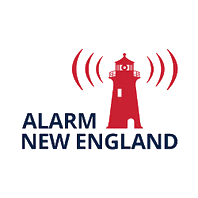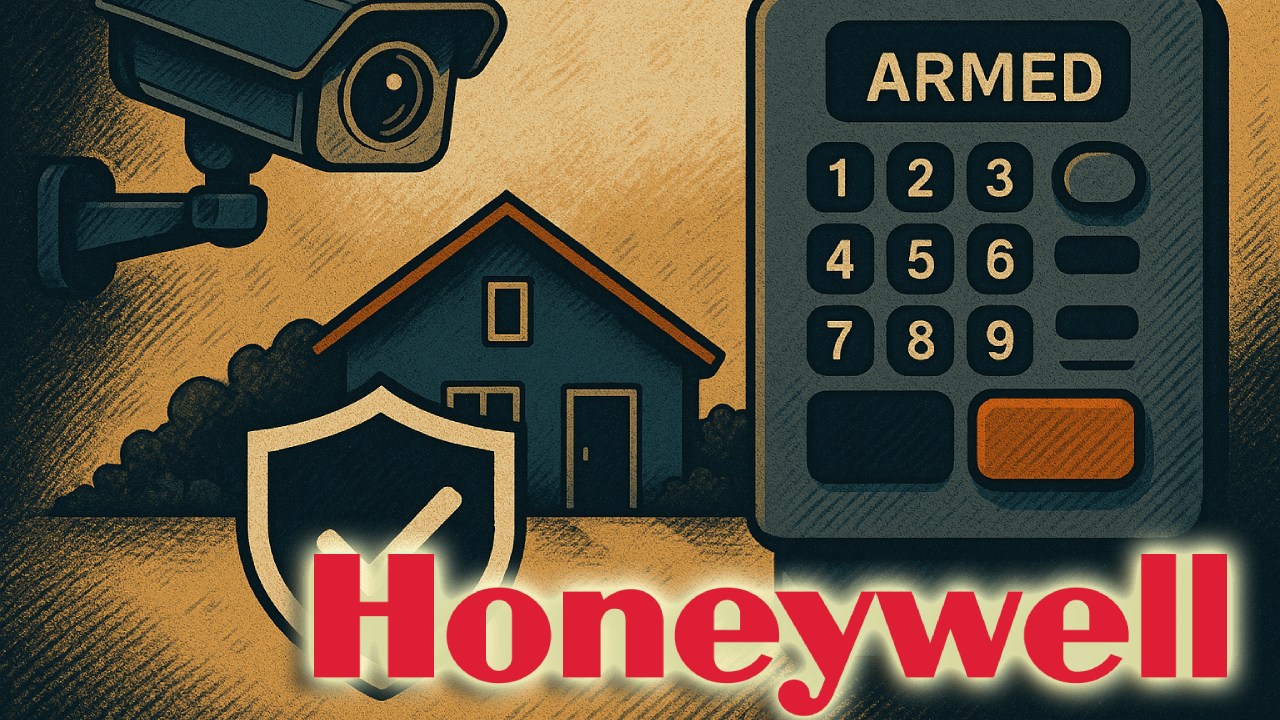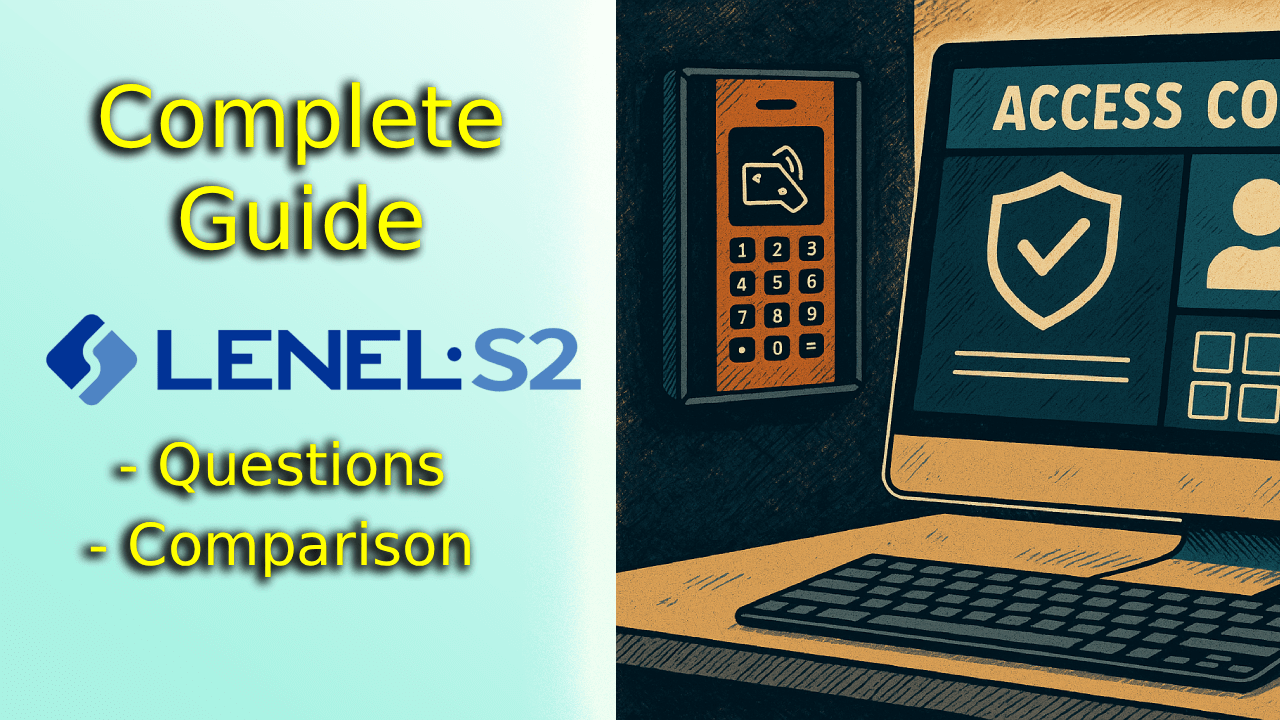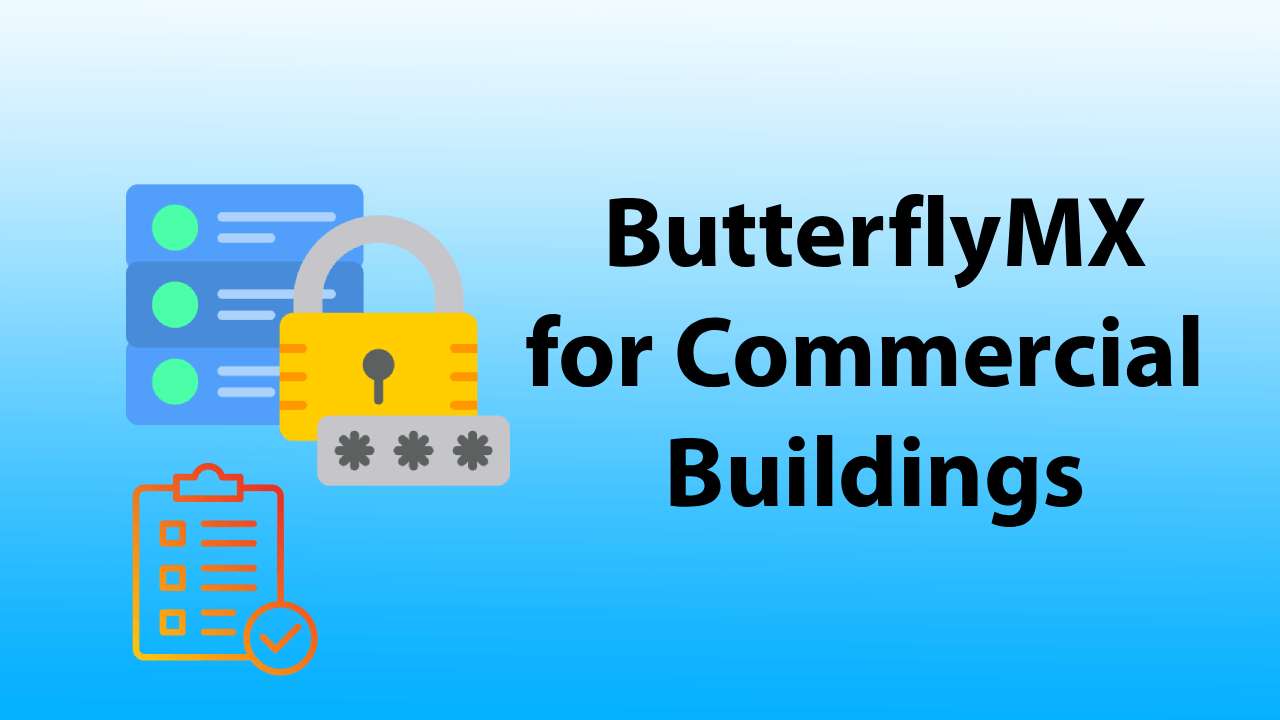When you think of Honeywell, you might picture thermostats or industrial equipment. But did you know this century-old company also makes some seriously impressive home security gear?
If you’re shopping around for a security system, you’ve probably stumbled across Honeywell’s name. The question is: should you actually choose them over the flashier competitors like Ring or SimpliSafe?
Let’s break down everything you need to know about Honeywell home security, from what they offer to whether it’s worth your hard-earned money.
Does Honeywell offer home security systems, and how do they work?
Yes, Honeywell absolutely offers home security systems, though they work a bit differently than what you might expect from companies like ADT or Vivint.
Here’s the thing: Honeywell primarily manufactures security equipment rather than providing direct monitoring services. They make the panels, sensors, cameras, and other hardware that form the backbone of many security systems across the country.
Think of Honeywell as the engine manufacturer rather than the car dealership. They build top-quality components that professional security companies and homeowners can use to create customized security setups.
The systems work through central control panels that communicate with various sensors and devices throughout your home. When a door opens, a window breaks, or motion gets detected, these sensors send signals to the control panel. The panel then triggers alarms, sends notifications to your phone, or alerts a monitoring center depending on how you’ve set things up.
Most Honeywell systems connect through both landline and cellular networks, giving you backup communication if one method fails. Modern Honeywell panels also support Wi-Fi connectivity for remote access through smartphone apps.
What equipment does Honeywell provide for homeowners?
Honeywell’s equipment lineup is actually pretty impressive. They’ve been in the security game long enough to know what homeowners need.
Control Panels and Keypads
The brain of any Honeywell system is the control panel. Their popular models include the Lyric Controller, which features a touchscreen interface, and the ProSeries panels that work with professional monitoring services. These panels range from basic models with simple keypads to advanced touchscreen versions with built-in cameras.
The keypads let you arm and disarm your system, check sensor status, and control various functions. Many models include backlit displays and voice prompts to guide you through different operations.
Door and Window Sensors
These are the workhorses of any security system. Honeywell makes both wired and wireless sensors that detect when doors or windows open. They’re surprisingly small and can blend into your home’s décor without standing out like a sore thumb.
The wireless sensors run on batteries that typically last several years before needing replacement. They communicate with the control panel using encrypted signals to prevent hacking.
Motion Detectors
Honeywell’s motion sensors use passive infrared technology to detect movement inside your home. They’re smart enough to distinguish between your cat wandering around at 2 AM and an actual intruder.
Pet-immune models can ignore animals up to a certain weight, so you don’t get false alarms every time your dog goes for a midnight snack.
Security Cameras
While Honeywell isn’t as camera-focused as Ring or Arlo, they do offer indoor and outdoor security cameras. These cameras provide HD video recording, night vision, and two-way audio communication.
Their cameras integrate with Honeywell’s Total Connect platform, letting you view live feeds and recorded footage from your smartphone. Some models include facial recognition and person detection features to reduce false alerts.
Glass Break Detectors
These sensors listen for the specific frequency of breaking glass. They’re useful for covering large areas with multiple windows without needing individual sensors on each one.
Smoke and Carbon Monoxide Detectors
Safety goes beyond security, and Honeywell offers detectors that integrate with their security systems. When smoke or carbon monoxide gets detected, the system can automatically unlock doors and alert emergency services through the monitoring center.
Smart Thermostats
Here’s where Honeywell really shines. Their Home and Lyric thermostat lines are among the best in the business. These devices learn your schedule, adjust temperatures automatically, and can be controlled remotely through your phone.
When integrated with your security system, the thermostat can automatically adjust when you arm or disarm the system, saving energy when you’re away.
Is Honeywell home security professionally monitored or DIY?
This is where Honeywell’s approach differs from companies like Ring or SimpliSafe. The answer is actually both, but with an important caveat.
Professional Monitoring Through Partners
Honeywell doesn’t offer direct-to-consumer monitoring services themselves. Instead, they partner with professional security companies that use Honeywell equipment. Companies like Alarm.com, Brinks Home Security, and various local security providers use Honeywell panels and sensors.
When you go through these partners, you get professional 24/7 monitoring. Trained operators watch your system around the clock and contact emergency services when alarms trigger. This typically costs between $30 and $60 per month depending on the features you choose.
Professional monitoring means you don’t have to worry about missing alerts if your phone dies or you’re in a meeting. Someone’s always watching your back.
DIY Options with AlarmNet and Total Connect
If you’re handy and want to save money, you can purchase Honeywell equipment and install it yourself. Their AlarmNet and Total Connect platforms let you self-monitor through smartphone apps.
With self-monitoring, you receive alerts when sensors trigger, and you’re responsible for checking the situation and calling authorities if needed. This eliminates monthly monitoring fees but puts the responsibility squarely on your shoulders.
The DIY route works well for tech-savvy homeowners who want complete control over their system. However, insurance companies often give bigger discounts for professionally monitored systems.
Hybrid Approach
Some security companies offer a hybrid model where you can switch between professional monitoring and self-monitoring as needed. This flexibility is handy if you travel frequently or want monitoring only during certain times of the year.
How does Honeywell integrate with smart home devices?
Smart home integration is where Honeywell really proves they’re keeping up with the times. They’ve made their systems play nicely with most major smart home ecosystems.
Amazon Alexa Integration
Honeywell security systems work with Alexa through the Total Connect skill. You can use voice commands to arm or disarm your system, check sensor status, and control connected devices.
Just say “Alexa, arm my security system in stay mode” before bed, and you’re protected without getting off the couch. Though for security reasons, you’ll need to use a PIN code to disarm the system through voice commands.
Google Home Compatibility
Google Home users get similar functionality. You can ask Google Assistant about your system status, control smart thermostats, and manage compatible devices through voice commands.
The integration works smoothly and responds quickly to commands, making it genuinely useful rather than just a gimmick.
Z-Wave Support
This is huge for smart home enthusiasts. Many Honeywell panels include built-in Z-Wave controllers, letting you connect hundreds of compatible devices without needing a separate hub.
You can control smart locks, lights, garage doors, and more through your Honeywell panel. When you arm the system at night, you can automatically lock doors, turn off lights, and adjust the thermostat with a single command.
Z-Wave creates a mesh network that makes your entire smart home more reliable. Each device acts as a repeater, extending the range and ensuring signals get through.
IFTTT Compatibility
If This Then That (IFTTT) support adds even more customization options. You can create custom automations like flashing smart lights when alarms trigger or sending specific family members notifications under certain conditions.
Apple HomeKit Limitations
Here’s one downside: Honeywell’s security panels don’t directly integrate with Apple HomeKit. Their thermostats do work with HomeKit, but the security systems themselves are left out of Apple’s ecosystem.
If you’re heavily invested in HomeKit, this might be a dealbreaker.
What does Honeywell home security cost, and are there monthly fees?
Money matters, so let’s talk numbers. Honeywell’s costs vary significantly depending on whether you buy equipment outright or go through a professional installer.
Equipment Costs
If you’re buying Honeywell equipment yourself, a basic starter kit with a panel and a few sensors runs between $200 and $400. A more comprehensive system with multiple sensors, cameras, and smart home integration can easily reach $1,000 to $2,000.
Individual components cost roughly:
- Control panels: $150 to $400
- Door/window sensors: $20 to $40 each
- Motion detectors: $30 to $60 each
- Glass break sensors: $50 to $80 each
- Security cameras: $100 to $300 each
Professional installation through a security company typically costs $99 to $300 upfront, though many companies waive installation fees if you sign up for monitoring contracts.
Monthly Monitoring Fees
This is where ongoing costs come into play. Professional monitoring through Honeywell’s partner companies typically ranges from $30 to $60 per month.
Basic monitoring plans usually include:
- 24/7 professional monitoring
- Emergency dispatch
- Basic mobile app access
- Email and text alerts
Premium plans ($50 to $60 monthly) add features like:
- Video surveillance storage
- Home automation controls
- Advanced mobile app features
- Smart home integration
If you self-monitor using Total Connect, expect to pay $6 to $13 per month just for app access and remote control features. While cheaper than professional monitoring, it’s not completely free.
Contract Requirements
Here’s something important: many professional installers require multi-year contracts, typically three years. Breaking these contracts early can cost several hundred dollars in cancellation fees.
DIY installations give you more flexibility since you own the equipment outright and can stop monitoring whenever you want.
Hidden Costs to Consider
Don’t forget about:
- Cellular backup modules: $100 to $150 (one-time)
- Cellular monitoring fees: $10 to $15 monthly
- Battery replacements: $20 to $40 every few years
- Service calls: $75 to $150 if something breaks
How reliable is Honeywell home security during internet or power outages?
Reliability during emergencies is crucial for any security system. Honeywell has built-in redundancies to keep protecting your home even when things go wrong.
Power Outage Protection
Every Honeywell control panel includes a backup battery that kicks in automatically when power fails. These batteries typically provide 4 to 24 hours of backup power depending on the system size and battery capacity.
The panel conserves energy during outages by reducing display brightness and limiting non-essential functions. Critical security features continue working normally.
Most systems alert you when running on battery power and warn you before the battery runs low. This gives you time to prepare or get power restored.
Internet Connectivity Backup
Here’s where Honeywell really shines compared to internet-only systems like Ring. Most professional installations include cellular backup communication.
If your internet goes down, the panel automatically switches to cellular networks to communicate with the monitoring center. This happens seamlessly without any action needed from you.
Cellular backup protects against savvy burglars who might cut phone lines or internet cables before breaking in. Your system stays connected and protected regardless of what happens to your landline or Wi-Fi.
System Resilience
Honeywell panels are built tough. They resist tampering and include anti-cut protection for wired sensors. Wireless sensors use encrypted communication that’s difficult to jam or intercept.
The systems also include supervisory signals where sensors regularly check in with the control panel. If a sensor stops communicating (maybe because a burglar disabled it), the system triggers a tamper alert.
Potential Weak Points
No system is perfect. If both power and battery backup fail, your system goes offline completely. Fortunately, this scenario is extremely rare.
Self-monitored systems without cellular backup depend entirely on your internet connection. If Wi-Fi goes down and you haven’t added cellular backup, you lose remote access and notifications.
How user-friendly is the Honeywell mobile app for homeowners?
Technology should make life easier, not more complicated. So how does Honeywell’s Total Connect app stack up?
Interface and Design
The Total Connect app features a clean, straightforward interface that’s easy to navigate once you get the hang of it. The home screen shows your system status at a glance with clearly labeled buttons for arming and disarming.
Is it the prettiest app out there? No. Ring’s app looks more modern and polished. But Total Connect prioritizes function over flash, and everything you need is accessible within a few taps.
Key Features
The app lets you:
- Arm and disarm your system remotely
- View real-time status of all sensors
- Watch live camera feeds
- Review video history
- Control smart home devices
- Receive instant push notifications
- Manage user codes
- View activity logs
You can also create custom rules and schedules. For example, automatically arm the system every night at 11 PM or turn off lights when everyone leaves home.
Performance and Reliability
The app generally performs well with quick loading times and responsive controls. Commands to arm/disarm or control devices typically execute within a few seconds.
Occasionally users report delays in notifications or connectivity hiccups, but these issues are fairly rare. The app works reliably on both iOS and Android devices.
Learning Curve
Here’s the thing: Total Connect isn’t quite as intuitive as Ring or SimpliSafe’s apps. New users might need 15 to 30 minutes clicking around to understand where everything lives.
The app includes tutorials and help sections, but they’re not as polished as some competitors. Once you learn the layout though, daily use becomes second nature.
Video Management
If you have Honeywell cameras, the app stores recorded clips in the cloud. Basic plans typically include 24 hours of storage, while premium plans offer 30 days or more.
Video quality is good, and the interface for browsing clips works reasonably well. However, it’s not quite as slick as dedicated camera apps from Ring or Nest.
Multi-User Access
You can grant access to family members, housekeepers, or trusted friends through the app. Each user can have different permissions levels, from full access to limited control.
What are the biggest advantages of Honeywell home security?
Let’s talk about what makes Honeywell stand out in a crowded market.
Proven Reliability and Longevity
Honeywell has been making security equipment since long before “smart home” was even a phrase. Their panels and sensors are built to last, often functioning flawlessly for 10 to 15 years.
This isn’t some startup that might disappear in three years, leaving your equipment unsupported. Honeywell’s been around since 1906 and will likely outlast all of us.
Professional-Grade Equipment
Many commercial buildings, banks, and government facilities use Honeywell security systems. You’re getting the same quality equipment protecting businesses protecting your home.
The components are more robust and reliable than budget consumer brands. They’re designed for 24/7 operation in harsh conditions.
Excellent Smart Home Integration
The Z-Wave support and compatibility with Alexa and Google Home give you tremendous flexibility. You’re not locked into a single ecosystem or limited to a handful of compatible devices.
This future-proofs your investment since you can add new devices as smart home technology evolves.
Flexible Monitoring Options
Unlike companies that force you into their monitoring service, Honeywell equipment works with multiple providers. You can shop around for the best monitoring prices or switch providers without replacing equipment.
This flexibility means you’re not trapped by a single company’s pricing or service quality.
What are the potential downsides compared to ADT, Ring, or SimpliSafe?
Nothing’s perfect, so let’s be honest about where Honeywell falls short.
Less User-Friendly Than Ring or SimpliSafe
Ring and SimpliSafe are designed specifically for DIY installation by non-technical homeowners. Their apps and interfaces are more intuitive and polished.
Honeywell’s professional-focused approach means steeper learning curves and less hand-holding. If you’re not comfortable with technology, you might feel overwhelmed.
No Direct Consumer Sales Model
Want to buy a complete Honeywell system with professional monitoring directly from Honeywell? You can’t. You must go through third-party dealers or install it yourself.
This adds complexity compared to simply ordering a Ring system from Amazon and activating monitoring through Ring’s app.
Higher Upfront Costs
Quality costs money. Honeywell equipment typically costs more upfront than budget systems from SimpliSafe or DIY options from Ring.
If you’re on a tight budget, spending $1,500 to $2,000 on a Honeywell system might not be realistic compared to a $300 SimpliSafe starter kit.
App Experience Lags Behind
SimpliSafe and Ring invest heavily in their consumer-facing apps, adding new features regularly and refining the user experience. Total Connect works fine but feels less modern and receives updates less frequently.
The app interface looks dated compared to sleeker competitors. It gets the job done but won’t impress anyone.
Limited DIY Support
If you install Honeywell equipment yourself and run into problems, good luck finding help. Honeywell’s consumer support is limited since they primarily support professional dealers.
Ring and SimpliSafe offer extensive DIY support with detailed guides, videos, and responsive customer service. Honeywell assumes a professional installer will handle issues.
Who is Honeywell home security best suited for?
So who should actually choose Honeywell? Let’s break it down by user type.
Homeowners Over Renters
Honeywell systems shine brightest for homeowners planning to stay put for several years. The higher upfront investment and installation complexity make less sense for renters who might move in a year.
If you own your home and want a system that’ll protect it for the next decade or more, Honeywell’s durability justifies the cost.
Renters are better served by completely wireless systems like SimpliSafe or Ring that move easily and don’t require professional installation.
Those Prioritizing Reliability Over Aesthetics
If you care more about your system working flawlessly than having the prettiest equipment or app, Honeywell delivers. This is security equipment built to industrial standards, not consumer electronics designed to look good on Instagram.
Smart Home Enthusiasts
The extensive Z-Wave support and integration options make Honeywell ideal for people who want their security system as the hub of a comprehensive smart home.
If you’re excited about automating everything and don’t mind spending time setting up custom rules, you’ll appreciate Honeywell’s flexibility.



![Ring vs. SimpliSafe vs. Vivint – Ultimate Comparison Guide [2025]](https://alarmnewengland.com/wp-content/uploads/ring-vs-simplisafe-vs-vivint.png)

